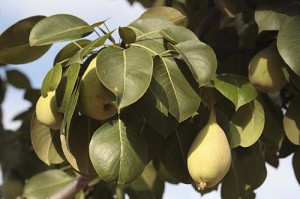I wanted to find the quince tree again.
It probably had been close to ten years since I last hiked my nearby Los Peñasquitos Canyon Preserve. Still I clearly remembered coming upon an ancient but still fruiting quince in one of the tributary canyon bottoms. Unwatered for decades and tended only by the wildlife, it had seemed like a miracle of survival in San Diego’s desert climate.
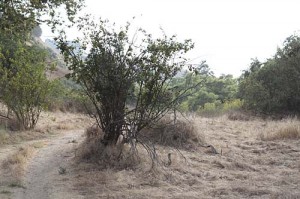 Last Saturday I scootered up to the preserve and started a slow stroll through the native willows and sycamores and oaks that line the dry creek in López Canyon. I only vaguely remembered the location, but less than half a mile in, right by the side of the trail, there it was, still very much alive, green and loaded with fruit.
Last Saturday I scootered up to the preserve and started a slow stroll through the native willows and sycamores and oaks that line the dry creek in López Canyon. I only vaguely remembered the location, but less than half a mile in, right by the side of the trail, there it was, still very much alive, green and loaded with fruit.
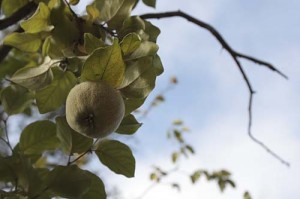
Nearby, in the shade of an old sycamore and crowded with some robust shrubs–including poison oak–I found a second tree with fruit on its branches.
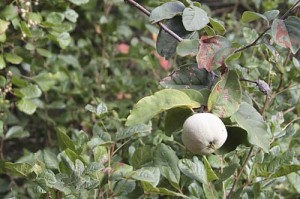
And then I started looking around in earnest. Off to the left stood a different kind of tree, either a different quince or maybe even a pear. It had a thick, creased trunk and the plant was clearly old. But the tree still drooped a little from the weight of the fruit.
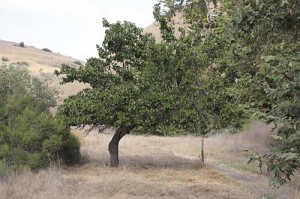 Not far ahead stood another specimen. Though without fruit it was clearly another fruiting tree, probably an apricot, judging by its leaves, a month after the last of its offerings would have been ripe.
Not far ahead stood another specimen. Though without fruit it was clearly another fruiting tree, probably an apricot, judging by its leaves, a month after the last of its offerings would have been ripe.
So that made for four trees that I could find without crawling through more poison oak or further through the snakey grass. I’m certain all the trees were many decades old, but exactly how old I couldn’t say for sure.
Local history places an orchard operator in this canyon as late as 1921, so some of the trees may date to then, though this area has been ranched and cultivated at least as early as the early 1800s, when this area was contained in the first of the Mexican land grants in Alta California, to as recently as 1962, when the land was acquired by the County.
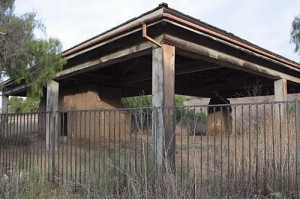 Nearby, under a protective shelter at the confluence of López Canyon and Los Peñasquitos Canyon, stand the remains of the Ruiz-Alvarado Adobe, one of the oldest structures in San Diego County.
Nearby, under a protective shelter at the confluence of López Canyon and Los Peñasquitos Canyon, stand the remains of the Ruiz-Alvarado Adobe, one of the oldest structures in San Diego County.
Anything older than a hundred years around these parts is considered a relic. If you were to believe the most wishful of the sources the adobe would date all the way back to 1815, though more reliable sources place its construction at 1857. This small adobe, along with a later, grander one to the east, became part of a thriving concern dedicated to ranching.
 Maybe it’s wishful and over-romanticizing on my own part–or maybe not–to imagine that the settlers who lived in this adobe planted the fruit trees in López Canyon. But the trees are as much of the human history of this area as are the few remaining adobe walls. Here we need all the history that we’ve got.
Maybe it’s wishful and over-romanticizing on my own part–or maybe not–to imagine that the settlers who lived in this adobe planted the fruit trees in López Canyon. But the trees are as much of the human history of this area as are the few remaining adobe walls. Here we need all the history that we’ve got.


